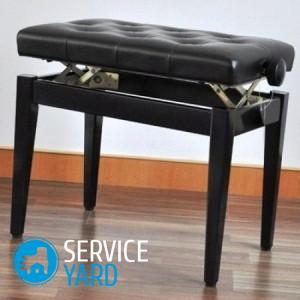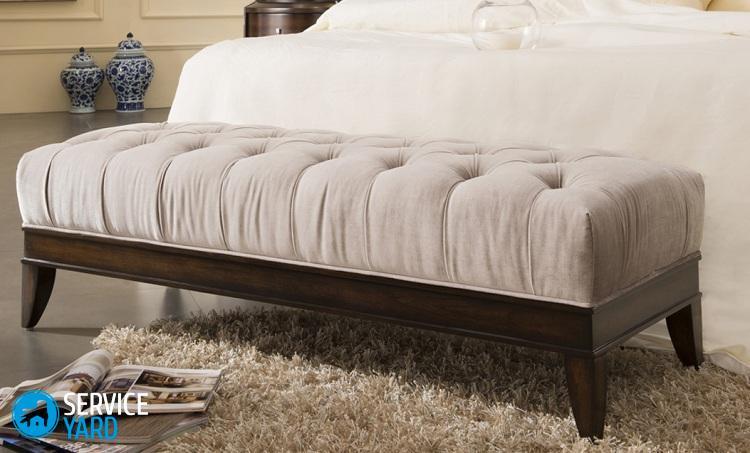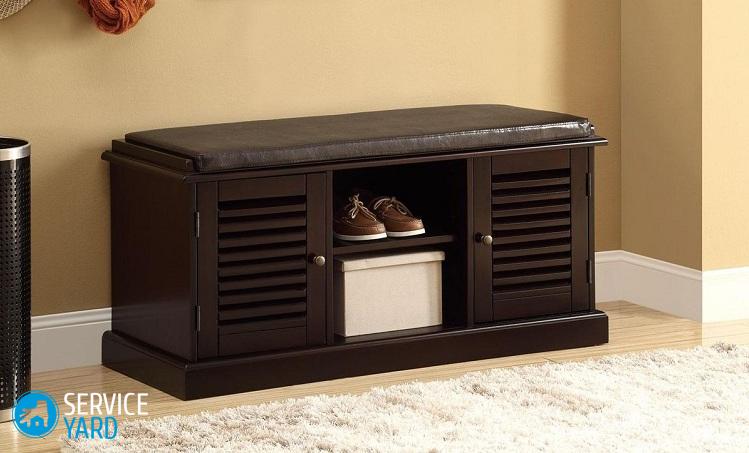DIY bench, quick and easy

A do-it-yourself bench is an incredibly beautiful decoration of your hallway interior, but it is not just beautiful, it is also multifunctional. And often, in order not to clutter up the space, it is better to use oversized, but nicely designed by design objects. Why is it needed at all, why is it multifunctional, what varieties of it exist, how to make it correctly, find out later in this article.
to contents ↑What is a bench?
Such a brilliant element of any interior, like a banquet, was invented in the not so distant XVIII century. It is a stool or a small bench with an upholstery, sometimes with a back. Some banquets also serve to store shoes, which makes them more functional. As a rule, they are made in the form of a rectangle, circle or square.
Such a product will be an excellent addition to the interior of absolutely any room:
- a banquet in the hallway - while tying shoes, you can sit on a ottoman, shoes are also often stored in it;
- a kitchen - a bench is often used as an addition to a soft corner;
- bathroom;
- bedroom - complements a calm and cozy atmosphere;
- living room - in this room this piece of furniture can act as an additional place for guests.
Materials and tools to be prepared
The material in order to make a banquet in the hallway with your own hands is a tree. Forged models, the frame, which is made of iron, require much more serious experience and skills.
For complete assembly of the product you will need:
- Wooden beam - 30 * 40, 30 * 50 mm, these parameters are applicable if the design provides for strapping and legs. The slats for a plywood product have a smaller section.
- You can use ready-made legs, for example, from a stool, a low coffee table, a bench.
- MDF panels or plywood - a list of relevant parameters for single, double, triple works.
- Fasteners require self-tapping screws, furniture corners, possibly pins, glue.
- For the soft part of a wooden banquet, you need to stock up with a filler and a cover.
Fabrics:
- The cover at home is made from a suitable fabric, for example: velor, plush, furniture upholstery. The material must be sufficiently dense and wear resistant. You can use leather or synthetic substitute.
- Foam is the material for filling, because it is sufficiently elastic and holds its shape for a long time.
Important! If you want to make a very soft seat, especially with a carriage screed, then in addition to foam rubber, use also a synthetic winterizer.
Instruments:
- drill, jigsaw, screwdriver;
- level, hammer, screwdrivers;
- threads and needles;
- construction stapler;
- different grit sandpaper.
Important! In addition, stain or paint and varnish may be needed.
The whole process consists of a small number of stages. They are quite simple in execution and require due care and accuracy.
to contents ↑Training:
- Create a product drawing, no matter how simple it may seem to you. Determine the size of the hallway and the most approximate product parameters.
- Calculate the capacity of the banquets, as one person occupies a plot of 45 * 55 cm.
- Choose a model with a back. It is quite difficult to implement with minimal experience, with drawers, shelves, legs.
- Knowing the dimensions of the seat, determine the parameters of all other elements and draw a sketch.
- If there are a lot of details - partitions, back, shelves, it makes sense to make a piece, and after that - proceed to cut the plywood shield.
- Cut out the details using a jigsaw, and sand the edges.
We assemble our product
We do not recommend that you make all the necessary details at one time, especially if this is your first experience in the manufacture of furniture: various deviations, as well as oversights, are always possible.
Frame:
- First of all, cut out the seat - its parameters serve as a starting point, and all other details, if there is such a need, are adjusted to the dimensions of this part.
- If you are making a model with legs, attach 4 wooden planks to the bottom so that they can protrude 1-2 cm beyond the edge.
- Fully sand the resulting workpiece and cover it with a stain, paint, clearly following all the instructions.
- If the model will rely on the sidewalls, here all the elements of the frame - the sidewalls, seats, the lower part of the shelf, as well as the back wall, cut immediately, sand them, and then assemble them using pins. To do this, pre-drill blind holes in the ends of the parts themselves.
Leg models:
- Produce legs from a wooden beam. The easiest option is to cut the bars to the height of the bench, then sand them, and fasten to the bottom with the help of corners and screws.
- The use of a hand mill can provide a more attractive appearance for the legs. The tool is quite simple and more affordable than a milling machine. With it, you can make the legs round, with protrusions, in any case smoother.
Important! Before fixing all the parts together, paint them and cover with a special varnish.
Seat:
- For a softer seat, cut out a piece of foam rubber of the required size.
- We recommend that you lay burlap or similar coarse material on the bottom at the beginning, and then fix the foam with a stapler or glue.
- Cut the selected fabric into fragments of the size you need, not forgetting to leave allowances for stitching.
- Wrap the fabric inward at the edges and secure with brackets.
We sew furniture on our own
The method described above allows you to ultimately get the product with a completely flat surface. But while on two- or triple versions this option looks quite presentable, a single-seat banquet will have a completely boring appearance. The pouf, which has a carriage screed, looks much more interesting.
To do this, take:
- the same tools, including a hand mill;
- softer and thinner fabric, because it will need to be folded;
- large buttons that are covered with exactly the same material.
Important! Filling in this case consists of two parts at once. Once you have glued the foam to the bottom, cut the same piece out of sintepon.
Manufacturing process:
- The places of fastening the buttons with some skills can be noted directly on the foam. But it is much more preferable to make a pattern: a sheet of paper of the appropriate size on which you can calculate the number of fasteners and the shape of the folds.
Important! As a rule, these are rhombuses, but you can also get more refined figures. Drill through holes at the marked positions.
- Lay the synthetic winterizer, with the help of a hand mill, cut out the holes for the buttons.
- Then place the fabric on the seat. It should be laid evenly, but without tension, because folds will form during fastening.
- After - sew buttons to the material in the previously marked places.
- Attach strong stern threads or cords to the buttons, pull them with a crochet hook through the holes and fasten with a stapler.
- Flatten the folds, you can steam the fabric if it becomes slightly creased during the upholstery.
Stock footage
Such a banquet with your own hands looks incredibly decorative, and making it is quite simple.
- How to choose a vacuum cleaner taking into account the characteristics of the house and coatings?
- What to look for when choosing a water delivery
- How to quickly create comfort at home - tips for housewives
- How to choose the perfect TV - useful tips
- What to look for when choosing blinds
- What should be running shoes?
- What useful things can you buy in a hardware store
- Iphone 11 pro max review
- Than iPhone is better than Android smartphones





